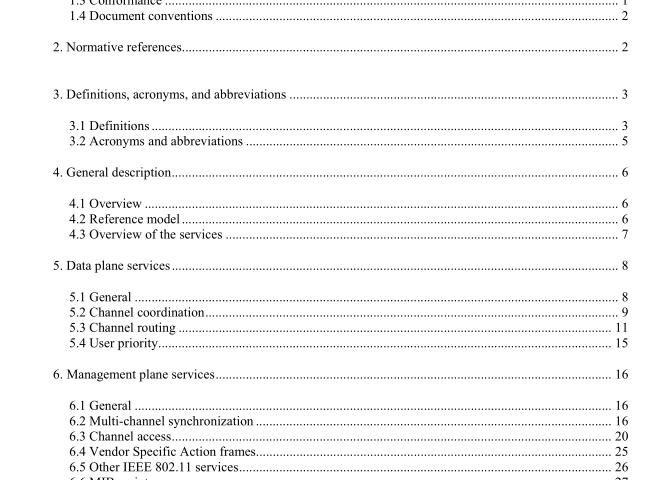IEEE 1609.4-2011 pdf download.IEEE Standard for Wireless Access in Vehicular Environments (WAVE)— Multi-channel Operation
4. General description
4.1 Overview
WAVE provides a communication protocol stack optimized for the vehicular environment, employing both customized and general-purpose elements. IEEE P1609.0 provides a description of the WAVE system architecture and operations. To operate over multiple wireless channels while in operation with OCBEnabled, there is a need to perform channel coordination. OCBEnabled indicates operation outside the context of a basic service set as specified in IEEE Std 802.11p (by setting dot11OCBEnabled to TRUE) (i.e., WAVE operation). Channel coordination is specified in this standard and consists of additional features for OCBEnabled operations in the MAC sublayer specified in IEEE Std 802.11p. Both data plane and management plane features are included as shown in Figure 1. These features are introduced in 4.2 and 4.3 and specified in Clause 5 and Clause 6.
4.2 Reference model
The basic reference model relevant to this standard is shown in Figure 1. WAVE supports both IP- and non–IP-based data transfers, although individual devices might support only one networking protocol. Non–IP-based data transfers are supported through the WAVE Short Message Protocol (WSMP) specified in IEEE Std 1609.3. Channel coordination is a collection of enhancements to the IEEE 802.11 MAC, and interacts with the IEEE 802.2 LLC and IEEE 802.11 PHY.
The WAVE Management Entity (WME) and corresponding network services are specified in IEEE Std 1609.3. WAVE security services are specified in IEEE P1609.2. The MAC and PHY layers conceptually include management entities, called MAC sublayer management and PHY layer management entities (MLME and physical layer management entity [PLME], respectively). These management entities provide the layer management service interfaces through which layer management functions may be invoked. In Clause 6, this document specifies extensions to the IEEE 802.11 MAC sublayer management entity (MLME; as amended by IEEE Std 802.11p) to provide channel coordination. The interactions between the various entities are through service access point (SAPs) across which defined primitives are exchanged; see Clause 7.
4.3 Overview of the services
4.3.1 General The services provided by this standard are used to manage channel coordination and to support MAC service data unit (MSDU) delivery. Both data plane and management plane features are specified.
4.3.2 Data plane services The MLME data services specified in Clause 5 comprise the following:
⎯ Channel coordination The MAC sublayer coordinates channel intervals so that data packets are transmitted on the proper RF channel at the right time.
⎯ Channel routing The MAC sublayer handles inbound and outbound higher layer data. This specification includes routing of data packets from the LLC to the designated channel, and setting parameters (e.g., transmit power) for WAVE transmissions.
⎯ User priority WAVE supports a variety of safety and nonsafety applications with up to eight levels of priority as defined in IEEE Std 802.11. The use of user priority (UP) and related access category (AC) supports quality of service using enhanced distributed channel access (EDCA) functionality specified in IEEE Std 802.11.
4.3.3 Management plane services
The MLME management services specified in Clause 6 comprise the following:
⎯ Multi-channel synchronization The MLME uses information derived locally and received over the air to provide a synchronization function with the objective of aligning channel intervals among communicating WAVE devices.
The MLME provides the capability to generate Timing Advertisement (TA) frames to distribute system timing information and monitor received TA frames.
⎯ Channel access
The MLME controls the access to specific radio channels in support of communication requests received from the WME.
⎯ Vendor Specific Action frames The MLME will accept incoming VSA frames and pass them to the WAVE Management Entity; the MLME will also generate VSA frames for transmission at the request of WME.
⎯ Other IEEE 802.11 services The MLME allows access to IEEE 802.11 services, which may be invoked on a per-channel basis.
⎯ MIB maintenance The MLME maintains a management information base (MIB) containing configuration and status information.
⎯ Readdressing The MLME allows device address changes to be triggered in support of pseudonymity.IEEE 1609.4 pdf download.IEEE 1609.4-2011 pdf download
IEEE 1609.4-2011 pdf download

Leave a Reply